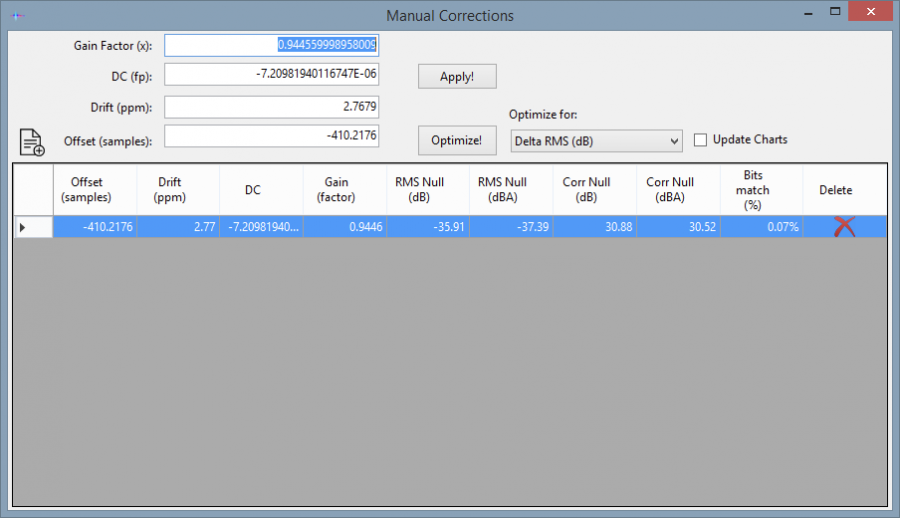The Manual Adjustment feature was the result of thinking how can DeltaWave results be trusted. Just because it has algorithms to determine various parameters, doesn't mean these algorithms work perfectly in every instance. So, the question raised by some here and on that other forum is valid: how to verify the reported results? Here's one idea: try to come up with a better solution yourself! Enter Manual Adjustments:
Manual Adjustment is available under
Process->Manual Adjustments menu. Run a
Match operation at least once before, so that you have a good starting point for the process. Here's what the interface looks like:

The settings up on top are all the variable parameters that DeltaWave tries to solve for:
- Level difference expressed as gain factor and DC offset, and
- Clock drift, and phase offset
When first shown, you will see the values that DeltaWave determined during the Match operation pre-filled, and the details of the result shown in the table below. Your mission, should you choose to accept it, is to find a better set of parameters that produce a better result than what DeltaWave found.
For example, if you decide that this DC offset appears very tiny and is probably the result of some noise in the tracks, simply change it to 0. That Gain factor looks suspiciously close to 0.95x, so let's change that as well, and then click
Apply! DeltaWave will take your new settings and apply them to the two waveforms on the main screen, compute resulting match and add a new row to the table with your settings and resulting null parameters:

As you can see, a little improvement in the A-weighted results, but slightly worse over the entire bandwidth. Adjust something else, and try again. You can go back to any of the previous attempts by just clicking on that row. This will copy all the settings into the edit boxes above, so you can continue modifying. If you find a result useless and want to get rid of it, just click on the red 'X' next to it. Press the clipboard button above the list on the left to copy the results into Clipboard. You can then paste them into a spreadsheet or another editor for safekeeping or further analysis.
You can see the results of the process in the main DeltaWave window. Each Apply will update all the charts and the Results tab, just as if the match was generated by DeltaWave.
At some point, you may get tired of editing various different parameters and keeping track of the results. When that happens, try the
Optimize! option. This is a completely automated process that will attempt to alter the settings in a semi-intelligent way to get an improvement in the chosen result. It'll continue running for quite a while. Just select the parameter you want to optimize for from the drop-down list, and let it go to work.
Optimize runs experiments, just like you would manually, by altering the parameters, running a test, and then comparing the results. It will continue running for a certain number of tries (usually 80 or so), or until you stop it by clicking the
Stop button. Only experiments that produce some improvement in any of the measurements are recorded in the list below. Leave the
Update Charts option unchecked to speed up the process, or turn it on if you want to see the charts update in the main window during optimization.
When finished (or stopped), you may indeed find a better combination of parameters than what DW had originally determined. Select that result by clicking on it in the list, and then press Apply! to see it processed in the main DW window. That's all there is to it!
The Optimizer starts working on the initial settings in the text boxes above. If you want to change the starting point to something completely different, just enter those parameters into the text boxes before clicking Optimize! As you can see in the results below, no clear winners, although some parameters did pretty well in the A-weighted part of the measurements!





